

Global oil markets are poised to swing from a deficit to a surplus next quarter should OPEC+ proceed with plans to boost supplies, data from the International Energy Agency showed.
Oil inventories are currently depleting as a result of peak summer driving demand, but should stabilize in the final quarter of the year, the Paris-based agency said in a report.
That would likely tip into an overhang if the OPEC+ cartel presses ahead with provisional plans to bring back idled output starting in October, the report indicated. Oil consumption in China, the biggest importer, fell for a third month in June, the IEA said.
“Despite the marked slowdown in Chinese oil demand growth, OPEC+ has yet to call time on its plan to gradually unwind voluntary production cuts starting in the fourth quarter,” according to the agency, which advises major economies.
Led by Saudi Arabia and Russia, OPEC+ has outlined a roadmap to revive about 543,000 barrels a day during the final quarter of the year, but stresses the plans could be “paused or reversed” depending on market conditions. A decision may arrive in coming weeks.
Crude prices have gyrated recently as the summer driving surge and concerns over escalating geopolitical tensions in the Middle East vie with signs of faltering economic growth in China. Brent futures are trading near $80 a barrel.
“For now, supply is struggling to keep pace with peak summer demand, tipping the market into a deficit,” the IEA said. “As a result, global inventories have taken a hit,” with stockpiles declining in June by 26.2 million barrels.
Unusually, growing demand in developed economies such as the US has been compensating for slackness in China and other emerging nations, it observed.
“A meaningful shift in drivers is becoming apparent,” the agency said. “The US economy, where one-third of global gasoline is consumed, has outperformed peers, with a resilient service sector buttressing miles driven.”
Yet the tightness prevailing now in global markets is due to fade.
Even if the Organization of Petroleum Exporting Countries and its allies cancel their scheduled output hikes, inventories will accumulate next year by a hefty 860,000 barrels a day amid booming supplies from the US, Guyana and Brazil, according to the IEA.
With crude prices too low for many OPEC+ members to cover government spending, traders and analysts are divided on whether the cartel will go ahead and open the taps.
In a separate report on Monday, OPEC trimmed its oil demand growth forecast for 2024 for the first time since it was introduced a year ago, citing softness in China. Its projections are still more than double the rate estimated by the IEA.
The IEA expects world consumption to increase by just under 1 million barrels a day, or roughly 1%, this year and next, as growth is tempered by the subdued economic backdrop and a shift toward electric vehicles. Demand will average 103.1 million barrels a day in 2024, it estimates.

From outstanding individuals to innovative organizations, find out who made the final shortlist for top honors at the IN awards, now in its second year.

Cresset's Susie Cranston is expecting an economic recession, but says her $65 billion RIA sees "great opportunity" to keep investing in a down market.

“There’s a big pull to alternative investments right now because of volatility of the stock market,” Kevin Gannon, CEO of Robert A. Stanger & Co., said.

Sellers shift focus: It's not about succession anymore.

Platform being adopted by independent-minded advisors who see insurance as a core pillar of their business.
RIAs face rising regulatory pressure in 2025. Forward-looking firms are responding with embedded technology, not more paperwork.
As inheritances are set to reshape client portfolios and next-gen heirs demand digital-first experiences, firms are retooling their wealth tech stacks and succession models in real time.
